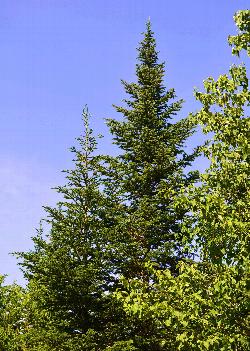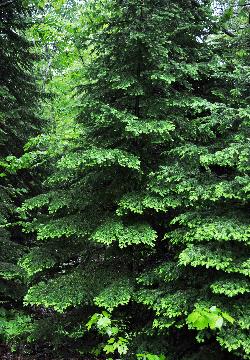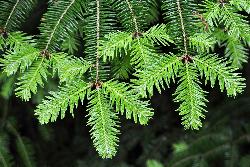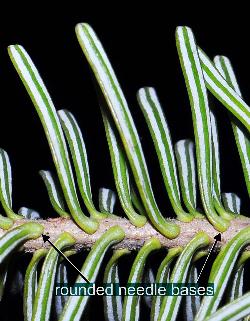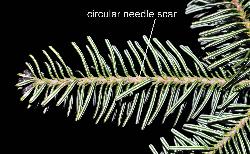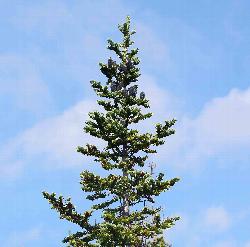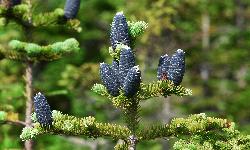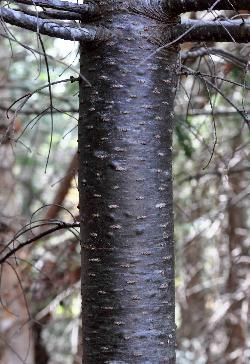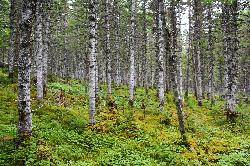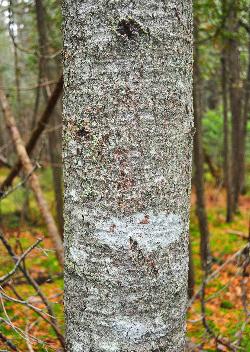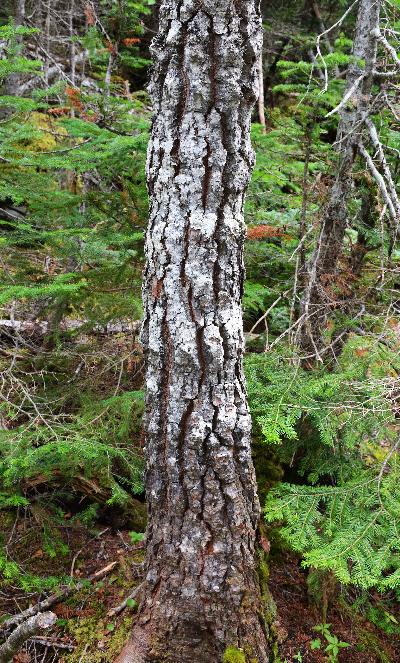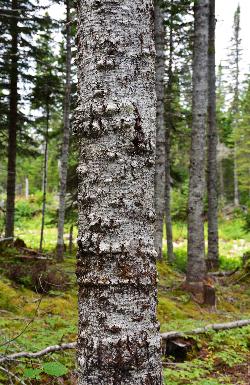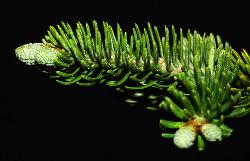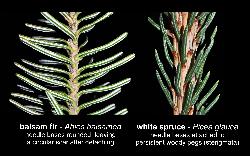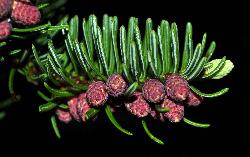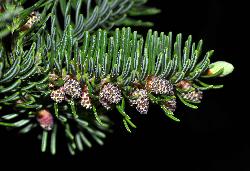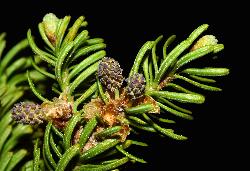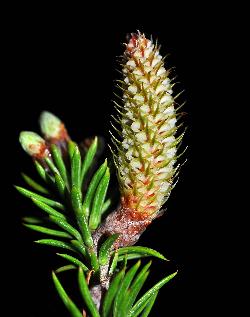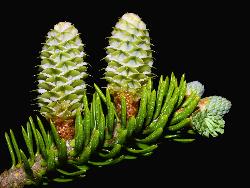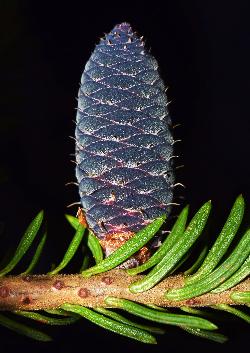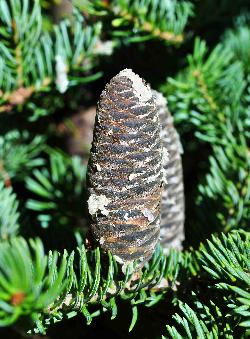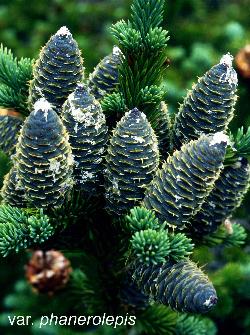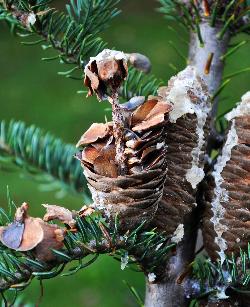Fr: sapin baumier, sapin balsamier, baumier du Canada, baumier de Gilead
IA: innasht
IU: killagittuk
Pinaceae - Pine Family
Note: Numbers provided in square brackets in the text refer to the images presented above; image numbers are displayed to the lower left of each image.
General: A medium-sized to tall evergreen conifer tree, to 25 m tall, with a 70 cm d.b.h., and living to about 150 years old (Farrar 1995). Balsam fir crowns taper gradually to a narrow conical spire-like top [1]; trees are shade-tolerant and shallow-rooted. Balsam fir, a common tree of the boreal forest, especially in eastern Canada, is a favoured Christmas tree species and an important source of pulpwood and lumber. Balsam fir forests provide a major source of browse and cover for moose, while old-growth fir-dominated forests are the preferred habitat for pine marten. The leaves and buds of balsam fir are eaten by spruce grouse and ruffed grouse, as well as red squirrels; also, a variety of insectivorous birds are attracted to balsam fir stands infested with spruce budworm (Choristoneura fumiferana (Clemens, 1865)), (Frank 1990, Uchytil 1991). The resinous blisters on younger balsam fir trunks are a source of an aromatic, turpentine-like oleoresin, commonly known as Canada balsam, which is used in microscopy, cementing optical systems, and as a component of certain medicinal preparations and varnishes (Bender 1967).
Key Features:
- Needle are flat, flexible, and spirally arranged, but appear 2-ranked on lower branches due to twisting of the leaf bases [2–3].
- The lower surface of needles has 2 prominent white lines running parallel to the midrib; tips of needles on lower branches are blunt to rounded [4].
- Needles are attached to twigs and branches by a flat round pad-like base that leaves a circular scar on the stem after falling [4–5].
- Cones are erect in upper branches [6–7]; cone scales separate with the mature seeds, leaving persistent naked cone axes on the upper branches for several years [8].
- Trunks of younger trees have numerous resin blisters that contain an aromatic sticky resin [9].
Stems/twigs: Young twigs are greyish to pale brown and finely pubescent; branching is usually opposite [4–5]. The ovoid buds are brown to dark purplish-black and often coated in resin, obscuring the rows of overlapping bud scales; needle scars are circular. The bark of younger trees is dark brown to greyish, fairly smooth, and bears numerous horizontal raised blisters [9] that contain an aromatic sticky resin; older trees have greyish-brown bark separating into small irregular scales [10–11]. While balsam fir trunks usually have relatively thin smooth bark, numerous balsam fir trees were observed in the Roddickton area with a thick outer bark (rhytidome) layer of deep ridges and irregular thickenings [12–13] (Bazukis and Hansen 1965). Balsam fir trees with similar bark features have been reported by local foresters as occurring most often on the Great Northern Peninsula, Western Newfoundland, and the Avalon Peninsula; suggested causes include heavy snow cover followed by spring thaws and frequent frosts, or fungal infection at the site of lateral branch breakage (CFSI, pers. comm. 2016); however, the exact cause is unknown.
Needles: Evergreen, simple, and sessile; individual needles may remain on a branch for up to 20 years. Needles are linear and flexible, 1.2–2.5 cm long by 1.5–2 mm wide, flat in cross-section, glabrous, and dark green. Needle apices are usually blunt to rounded; bases narrow to a flat circular pad that leaves a circular leaf scar after needles fall [4–5]; margins are entire. Needles are spirally arranged around the stem, but lower horizontal branches have bases twisted so that needles appear 2-ranked (opposite and flattened in one plane) [3, 14]. Terminal and upper branch leaders often have stiff spirals of sharply pointed (acute to acuminate) needles [15], similar to spruce needles, but the circular pads at the needle bases will distinguish fir from spruce [16]. The lower needle surface is marked below with 2 distinct white lines, one along either side of the midrib [17], which are composed of several vertical rows of stomates. Individual stomates are visible on young needles as minute dots, but a glaucous waxy coating develops around the stomates, forming the solid white lines on mature needles. The upper surface has a less defined single vertical band of stomates along the middle of the needle.
Reproductive structures/cones: Unisexual, with both male and female cones borne on the same tree (plants monoecious). Male (staminate) cones originate from the leaf axils of needles on year-old growth; the cones are small and ovoid, but become pendant as pollen is shed [18–20]; pollination is by wind (anemophily). Female (pistillate) cones are cylindrical, 4–7 cm long by 1.5–3 cm wide, erect, and clustered along the top of the upper branches. Immature female cones (conelets) are initially whitish-green [21–22], then blue-grey, finally becoming greyish-brown to brown at maturity [23–25]. Bracts subtending the obovate cone scales in the typical variety (var. balsamea), are usually shorter than the scales and thus not visible between the cone scales [25]. Plants classified as var. phanerolepis Fernald have longer bracts with slender tail-like tips that extend beyond the edge of the cone scales [26]. Both varieties are present in Newfoundland and Labrador. Seeds are ± triangular, brown, 3–6 mm long, with a thin obovate wing 2–2.5 times as long as the seed. Balsam fir cones mature in one growing season. When seeds mature, the deciduous cone scales and bracts fall with the wind-dispersed seeds [27], leaving the persistent cone axes standing erect along the upper branches [6, 8].
Ecology & Habitat: Balsam fir may occur in all forest sites in Newfoundland and Labrador, up to approximately 60° N latitude, and is frequently the dominant species in alpine and coastal treeline zones, where it can occur as krummholz in snowbed communities. It is most vigorous and abundant on well drained to moist sites in humid coastal areas that rarely experience wild fires. Balsam fir is a shade-tolerant species that readily regenerates from abundant seedlings in the understory after windfall, insect mortality, or harvesting.
Edaphic Grid: See image [28]: the Edaphic Grid for Abies balsamea.
Forest Types: The most common subassociations in which balsam fir occurs are:
- Abietum typicum (Pleurozium-Balsam Fir Forest Subassociation)
- Abietum hylocomietosum (Hylocomium-Balsam Fir Forest Subassociation)
- Abietum dryopteretosum (Dryopteris-Balsam Fir Forest Subassociation)
- Abietum rubetosum (Rubus-Balsam Fir Forest Subassociation)
Balsam fir is frequently replaced as the dominant tree by black spruce and pines on the extremely dry subassociation Kalmieto-Piceetum cladonietosum (Cladonia-Kalmia-Black Spruce Forest Subassociation). Black spruce and tamarack usually replace balsam fir on extremely wet sites, including the Kalmieto-Piceetum sphagnetosum (Sphagnum-Kalmia-Black Spruce Forest Subassociation), the Sphagno-Piceetum (Sphagnum-Black Spruce Bog Subassociation), the Osmundo-Piceetum (Osmunda-Black Spruce Fen Association) and the Carici-Piceetum (Carex-Black Spruce Fen Association). However, balsam fir can dominate on the wet Abietum sphagnetosum (Sphagnum-Balsam Fir Forest Subassociation), found in the very humid coastal climates of the Northern Peninsula and southeastern Newfoundland.
Through most of its range, balsam fir occurs on acidic soils, but in western and northern Newfoundland, the Abietum taxetosum (Taxus-Balsam Fir Forest Subassociation) forms a unique forest type on shallow soils derived from limestone or compacted calcareous till.
Succession: After fire, balsam fir is replaced by black spruce on most well drained upland sites of the Piceetum marianae (Black Spruce Forest Association), but may be replaced by white birch, yellow birch, or aspen of the Betuletum papyriferae (White Birch Forest Association) on rich seepage slopes. Individual balsam fir trees rarely survive fire because of their thin highly resinous bark. Also, balsam fir forests rarely regenerate adequately after fire because the resinous cones are consumed by fire. Furthermore, seeds are shed annually, so a mature seed crop does not occur in the crown during the spring and summer fire season. Exceptions to this trend can occur in the case of crown fires that do not consume the abundant advance regeneration in the understorey.
Distribution: In Canada, balsam fir is primarily a central and eastern species, occurring as far north as the Hudson Bay lowlands in Ontario, the central Ungava Peninsula in the interior of Québec, and Nain on the northern coast of Labrador. It also occurs more sporadically west to Alberta and south to Maine, Minnesota, and within the Appalachian Mountains, at elevations up to 1800 metres as far south as West Virginia.
Similar Species: In Newfoundland and Labrador, the only conifer species that may be confused with young balsam fir regeneration is Canada yew (Taxus canadensis Marshall), a low evergreen shrub with flat needles. When fertile branches are present, the red aril surrounding the seed of Canada yew easily differentiates yew from fir. With vegetative branches, Canada yew needles can be identified by their soft pointed apices, decurrent needle bases, and green twigs, while balsam fir has needles with rounded apices (usually) and flat rounded pad-like bases that leave circular needle scars on woody twigs. The presence of naked cone axes, which are persistent on upper branches after cone scales and seeds are shed, is another key trait to identify balsam fir in the canopy. Balsam fir can be readily distinguished from spruce trees by the shape and attachment of the needles; spruce needles are stiff, angular in cross section, have sharply pointed apices, and are attached to the stem by short peg-like woody bases called sterigmata, which remain on the twigs after spruce needles are shed [16].


